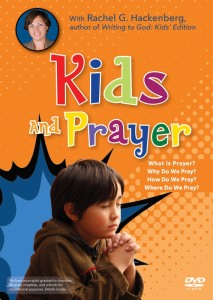Have you entered your name in this week’s giveaway drawing to win a free copy of the Kids and Prayer DVD? This fun resource, with four kid-friendly episodes about the basics of prayer, is a $50 value for your church or home library to support important conversations about prayer with the young people in your life. Enter to win by sending me an email with the subject  “Prayer DVD” by Sunday May 28 [contest now expired].
“Prayer DVD” by Sunday May 28 [contest now expired].
Don’t just enter to win Kids and Prayer for your bookshelf, however. Enter to win and use Kids and Prayer!
For example, perhaps you have the responsibility of crafting a multi-age Sunday School program for this summer, and you’d like to use Kids and Prayer for a program focused on prayer. For a twelve-week Sunday School summer outline, here are ideas for using the theme of each Kids and Prayer episode across three consecutive Sundays:
- “What Is Prayer?” Show the first episode, then ask the youngest kids to explain to the oldest youth what prayer is. Have the oldest ones retell the episode’s Bible story to the youngest ones, along with their understanding of how the story relates to prayer. Cut out construction paper hands, glue wiggly eyes on styrofoam balls, paint a portrait of your neighbor’s ear, and talk about how our bodies experience prayer (mindful of ableism): for example, our eyes might not actually see God, but our hearts try to “see”/understand God a little better every time we pray.
- Continue with “What Is Prayer?” If your Sunday School classroom has high turnover in its attendance during the summer months, consider playing the first DVD episode again. Play a game of Telephone to demonstrate how poorly we listen to one another, contrasted with how well God hears us. Ask the older youth especially to reflect on the difference between being heard and being answered, so kids of all ages can wonder together about how to believe that God hears them even if an answer isn’t immediate or obvious. Practice prayers of amazement with Psalm 8 — either use Psalm 8 as an example or read it aloud with kids responding “Wow, God” after each line.
- Third Sunday of the “What Is Prayer?” theme and episode. Look at the story in Genesis 18:3-5, sing “Kumbayah (Come By Here),” and discuss how we invite God to come and talk about the world with us. How did Abraham prepare a meal for his guests? How would you set a table where God is one of the dinner guests? Practice setting a table, and get creative in table displays, decorative plates, etc. Let everyone say their own prayer at the table.
 Fourth Sunday, it’s time for the second Kids and Prayer DVD episode, “Why Do We Pray?” Once again, ask the youngest to explain to the oldest youth why we pray after watching the episode, and then have the oldest retell the episode’s Bible story to the youngest, along with their understanding of how the story relates to prayer. Take turns acting out various emotions — happy, sad, grumpy, lonely, excited — and talk about why we might pray to God when we’re in these different moods. Teach a prayer to be memorized or use Writing to God: Kids’ Edition to prompt the group with their own prayers.
Fourth Sunday, it’s time for the second Kids and Prayer DVD episode, “Why Do We Pray?” Once again, ask the youngest to explain to the oldest youth why we pray after watching the episode, and then have the oldest retell the episode’s Bible story to the youngest, along with their understanding of how the story relates to prayer. Take turns acting out various emotions — happy, sad, grumpy, lonely, excited — and talk about why we might pray to God when we’re in these different moods. Teach a prayer to be memorized or use Writing to God: Kids’ Edition to prompt the group with their own prayers.- Continue with “Why Do We Pray?” Bring newspapers and magazines and ask kids to cut out something they want to pray about — a person or place or event that they want to make sure God is paying attention to. Make a display of the group’s prayer concerns and put it in the church somewhere with the encouragement that others add their own prayers to the display. Don’t be afraid of the hard questions in conversation with kids: What difference does it make that we pray for something that we can’t fix? What if God doesn’t fix it either? Be willing to not settle for easy answers.
- One more Sunday on “Why Do We Pray?” Paint rocks in class, teaching and affirming that God is like a rock — reliable across time, strong through change, able to withstand even our hardest questions (I don’t recommend limestone). Affirm the good news of Matthew 10:30-31 — God knows you, God loves you, God cares when you feel like you’re flying confidently like a sparrow and God cares when you’re falling.
- On to the third episode of Kids and Prayer, “How Do We Pray?” Ask the youngest to explain to the oldest how we pray, based on what they’ve learned from the DVD, and then have the oldest retell the episode’s Bible story to the youngest. If the weather’s nice and you can go outside easily, take a walk and practice praying along the way: “Thank you, God, for the apartment building!” “Wow, God, look at the ants climbing over one small crumb!” “
- Continuing with “How Do We Pray?” break the large group into smaller multi-age groups, with an assignment to each group to write a prayer in a different style: confession, thanksgiving, etc. (Encourage younger ones to generate ideas for the prayer, with older ones assigned to write.) Have the small groups put their prayers on poster board, with decorations and designs that reflect the mood/theme of their prayers. Read the prayers aloud.
- With a little advance homework on your part, bring psalms of varying moods for another Sunday of “How Do We Pray?” Work together or in small groups to understand the psalms’ meanings — does the psalm pray about a leader? is the psalmist mad at God or scared of God? etc. — and then take turns acting out the psalms once they’re understood. Ask each actor how they might pray in similar circumstances.
- The fourth episode of Kids and Prayer is “Where Do We Pray?” which hints of fun excursions for the final weeks of your summer program. First make sure the DVD episode is understood by all, by asking the youngest to explain to the oldest where we can pray and asking the oldest to retell the episode’s Bible story to the youngest. Wander around your church as a group in search of “pray-able” spaces: the sanctuary? the front door? the kitchen?
- As “Where Do We Pray?” continues, take time to retell (briefly) the story of the ancient Israelites wandering from Egypt across the Red Sea to Mount Sinai to the border of the Promised Land to random meandering through the wilderness and back to the Promised Land. A map can help demonstrate your point that the people prayed everywhere they went! Ask kids to draw “maps” (can be loosely interpreted) of all they places they go on an average day and identify which locations are “pray-able” spaces.
- To conclude the “Where Do We Pray?” part of your summer series, ask kids if there’s anywhere they can go that God is not. Consider the stories of Elijah who God found in a cave on a mountain … of Jonah who God found hiding (not very well) in a fish & then under a bush … of Peter who tried to hide out beside a campfire after Jesus was arrested. Play a game of hide-and-seek. If you’re not anxious about crumbs, include snacks as part of what’s hidden and needs to be found.
Check out other program ideas I’ve posted on my blog this week, but most of all be sure to enter this week’s drawing for a free copy of the Kids and Prayer DVD! All you need to do is drop me an email with the subject “Prayer DVD” and I’ll put your name in the hat. The drawing will be held at 5:00pm eastern on Sunday, May 28 [contest now expired].

Trackbacks/Pingbacks